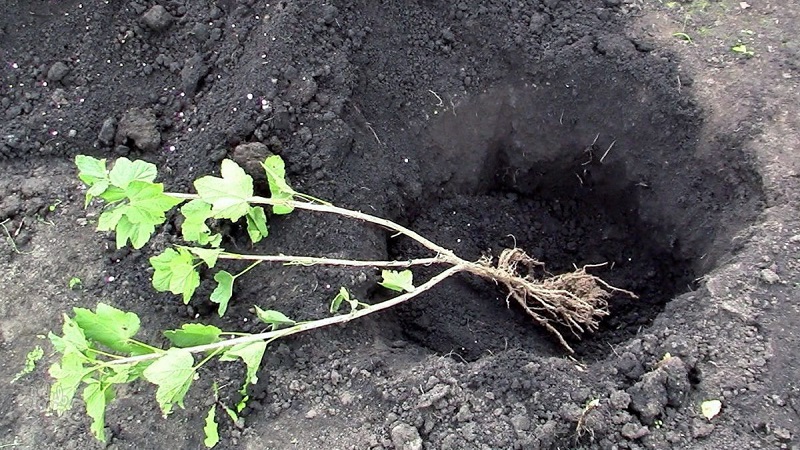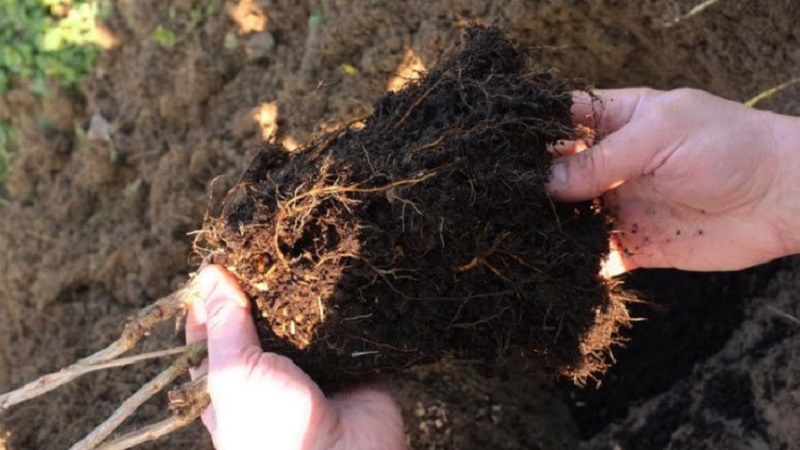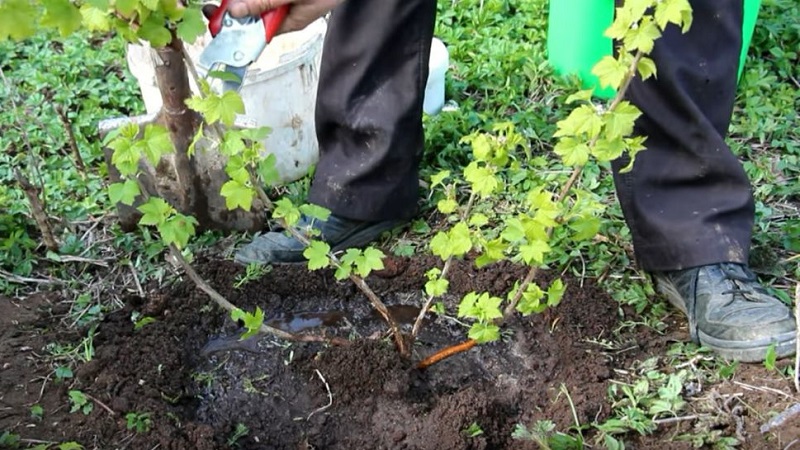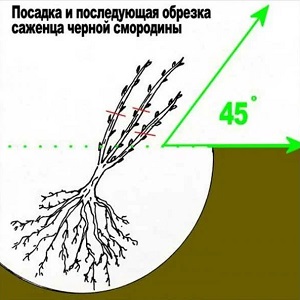Fall currant planting guide for beginner gardeners
Currant is rich in vitamins A, C, E, P and group B, recognized as a valuable food and medicinal plant. Therefore, it is very popular and can be found in almost every household plot.
When and how to plant currants to grow a rich harvest - read on.
The content of the article
When is it better to plant currants - in spring or autumn
You can plant currants both in spring and autumn. But it is better to do this in the fall, when ideal conditions for survival are created:
- seedlings and cuttings root quickly and go through the adaptation period well;
- the activity of pathogens and pests decreases;
- after the autumn planting in the spring there is a faster, amicable awakening of the buds and the regrowth of young shoots.

Can I plant in summer
Transplanting currants in the summer is impractical, since it is in a phase of active growth and development. Even in the spring, they strive to plant it before bud break. They do this only if absolutely necessary, if necessary, for example, to free up space for other purposes. Then they dig a hole, water it with water, plant it after being absorbed and water it again.
In large bushes, about half of the branches are cut off from the ground... From the south side, they shade from the bright sun. The first week, the leaves are watered 2-4 times by sprinkling, since they need moisture, but the roots have not yet taken root and the water is not pumped. The harvest of such a bush, if it does, is very poor.
Ideal planting dates
In autumn, currants are planted about three weeks before the arrival of the first frost... During this period of time, the seedling will root well, but it will not have time to release young shoots.
When choosing the time for planting currants, it is of great importance region and typical weather conditions.
Interesting on the site:
Step-by-step instructions for planting cherry plum in the fall
The best varieties of currants for autumn planting
Not all currant varieties are suitable for planting in the fall. It is recommended to take one of the following:
- Dobrynya - large black currant, berries weigh up to 7 g. Ripening period - the second half of July. Differs in winter hardiness, early maturity and resistance to powdery mildew.
- Selechenskaya-2 (pictured below) - black currant, berry weight - up to 6 g. Refers to varieties of early ripening. High-yielding, frost-resistant and resistant to diseases and pests.
- Sevchanka - self-fertile universal variety of black currant with good yield of large berries (up to 5 g), which do not crumble and are well stored. Frost-resistant, zoned in Siberia. Resistant to rust and powdery mildew.
- Cherry - a variety of Ukrainian selection. The berries are large, up to 7 g, pleasant to the taste, easily plucked and well transported. The bush can withstand frosts down to -30 ° C.

Selection and preparation of seedlings
The future harvest of berries largely depends on the quality of the seedling. There are several options for preparing planting material.:
- harvesting cuttings from an old currant bush;
- purchase of a seedling of the required variety;
- growing from a grafted bush.
Better to plant a proven berry variety... To do this, you need to separate the current year's shoot from the old bush and plant it in a previously prepared place.
When buying a seedling, pay attention to the following signs:
- well-developed root system (3-5 lignified skeletal roots up to 18-20 cm long, developed fibrous system);
- the presence of 2-3 aerial shoots up to 30-40 cm high;
- formed buds on the stems;
- absence of signs of diseases and pests;
- stems and roots intact.
When buying a currant seedling you need to choose a variety that is zoned in the region.

Experienced gardeners grafted on a currant bush a cutting of a different variety... A year later, in September, a shoot is separated from this inoculation for planting a new bush.
When moving or waiting for planting, the root system of the seedling must be wrapped with a damp cloth and polyethylene on top so that the roots do not dry out.
How to properly make an autumn planting of currants
When planting a crop, it is necessary to fulfill a number of conditions so that the seedlings take root and further delight with the harvest.
Seat selection
Before planting, you need to decide on the site. Consider the following parameters: soil composition, illumination and humidity, predecessors and neighbors.
Currant loves fertile, black earth, loamy soil with a neutral or slightly acidic reaction.

Currant gives rich yields in a well-lit place... She can withstand light shading, but in deep shade her branches stretch out, few buds are formed, and the berry harvest will be small.
Attention! Currants love areas protected from the wind.
The berry loves moisture in the soil and air... But in places with stagnant groundwater, it grows poorly, the main trunks are covered with lichens and begin to hurt.
Good predecessors are considered perennial grasses, row crops and vegetables. Currants should not be planted in areas where raspberries, gooseberries and currants themselves used to grow.
Neighborhood with raspberries, sea buckthorn, gooseberries and trees (cherries, walnuts or pine).
Required materials and tools
For landing you will need shovel, bucket or watering can, secateurs, gloves, insulation, wood ash, mineral and organic fertilizers.
Step-by-step instruction
2-3 weeks before planting currants, prepare the soil... If there are holes on the site, they are covered and leveled. The earth is dug to a depth of 40-50 cm. At the same time, it is evenly applied per 1 sq. m 7-10 kg of organic fertilizers (humus), 1 liter of wood ash, 500 g of dolomite flour and 100 g of superphosphate. The planting hole is dug 50 cm long and 50 cm wide.
Attention! When digging, remove all wheatgrass - the currant does not like it.
When planting a seedling, carefully examine the root system... Dried and damaged roots are removed with pruning shears.

In a well prepared in advance, soil is poured onto the nutrient mixture a layer of about 5-7 cm to prevent root burns. Watered at the rate of 8 liters of water per hole.
The seedling is placed in the hole so that the root collar after planting is 5-10 cm below the level of the soil edge. Depending on the planting method, the seedling is placed vertically or at an angle of 45 degrees.
All the roots are straightened and covered with soil... To eliminate air pockets, the seedling is slightly shaken during planting. At the end of the process, the soil around it is compacted.
Take a note:
Next, the seedling is cut: with pruning shears, the stems are shortened so that there are segments 12-15 cm long with 3-5 buds.
Then watered again, and the soil around the seedling is mulched peat, humus or sawdust.

What mistakes to avoid
Even experienced gardeners can make mistakes when planting currants, so you must adhere to certain rules.
- Currants must be placed in one place, and not distributed throughout the entire plot of the cottage. So in the root zone more moisture will be retained, which will increase the yield.
- You cannot plant currants in a freshly prepared area, since the soil has not been compacted, and you can make a mistake when deepening the root collar of the bush.
- You cannot apply more than the prescribed rate of mineral fertilizers. This contributes to the formation of an aggressive environment in which beneficial bacteria will die, and currant roots will get burned.
Do not plant a seedling with dry roots. - most likely, he will die. If the roots are dry, the bush must be placed in water for two days before planting.
Planting methods
There are several ways to plant:
 Classical... The seedling in the hole is placed at an angle of 45 degrees. After light compaction of the soil, the roots are buried by 10-12 cm. The lower part of the stems, up to 3-4 buds, are also covered with earth. In the spring, young shoots will grow from them. The stems are pruned so that 3-5 buds remain above the soil.
Classical... The seedling in the hole is placed at an angle of 45 degrees. After light compaction of the soil, the roots are buried by 10-12 cm. The lower part of the stems, up to 3-4 buds, are also covered with earth. In the spring, young shoots will grow from them. The stems are pruned so that 3-5 buds remain above the soil.- Fanny... With this method, one must take into account that the branches of the plant will hang on shortened trellises. The seedling is placed vertically when planting.
- Shpalerny... Before planting, all root buds and small shoots are removed from the seedling. It is planted vertically, but the branches are not pruned.
At what distance and at what depth to plant
With any planting method, up to 1.5 m is left between the bushes, and up to 2-3 m between the rows... This distance will allow the currants to grow freely and bear fruit well. The earth is dug to a depth of 40-50 cm and a hole is formed with a length and width of 50-60 cm.To plant an adult plant, the hole must be 15-20 cm deeper and wider.
How to plant currants from a bush (multiply)
Use vegetative propagation: layering, green and lignified cuttings and dividing the bush.
The division of the bush is carried out in the fall... The bush is cut into 2-3 parts with a tool with well-developed roots and shoots. Sections near the bush are lubricated with wood ash and planted in a permanent place. They will bear fruit in a year.
Reproduction by layering is carried out at the end of May... They take a healthy, two-year-old branch located close to the ground and drop it 10-15 cm deep in a previously prepared and fertilized area. The top of a branch up to 30 cm in size should be above the soil. You can attach it to the ground with a bracket. During the summer, the cuttings are watered and fed. By the end of September, 3-4 shoots will grow and a root system will develop. Then it is separated and transplanted.
For propagation by cuttings, a young shoot is cut into cuttings with a sterile tool up to 20 cm long - so that the lower cut is oblique, and the upper one is straight. The work is performed in the middle of autumn. Cuttings are placed in water overnight, and the next day they are planted in prepared holes.

Further care of the seedling in the fall
After planting, it is necessary to take care of the bush so that it quickly takes root and overwinters safely. This requires:
- in dry autumn, often water with warm water;
- mulch the soil surface with compost or peat in a layer up to 10 cm;
- hilling seedlings so that a crust does not form on the ground;
- in late autumn, before frosts, cover the plantings with insulation (film).
Conclusion
Currant is a useful, medicinal berry that requires little effort from the gardener and minimal costs. Even a beginner can handle her planting and reproduction.
If you carefully choose a place for the currant, prepare the soil, plant it according to all the rules and take care of it after planting, it will delight you with a rich harvest.